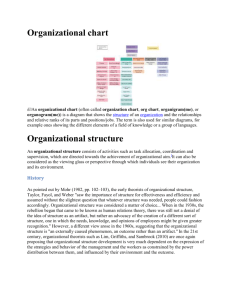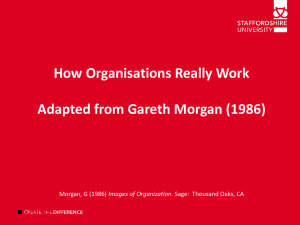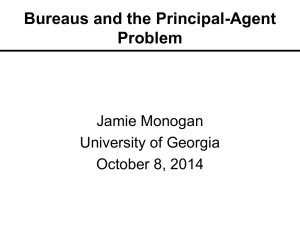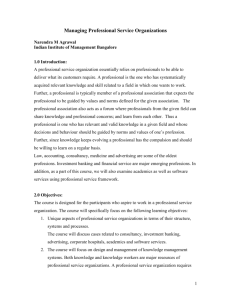Organisational Design
advertisement
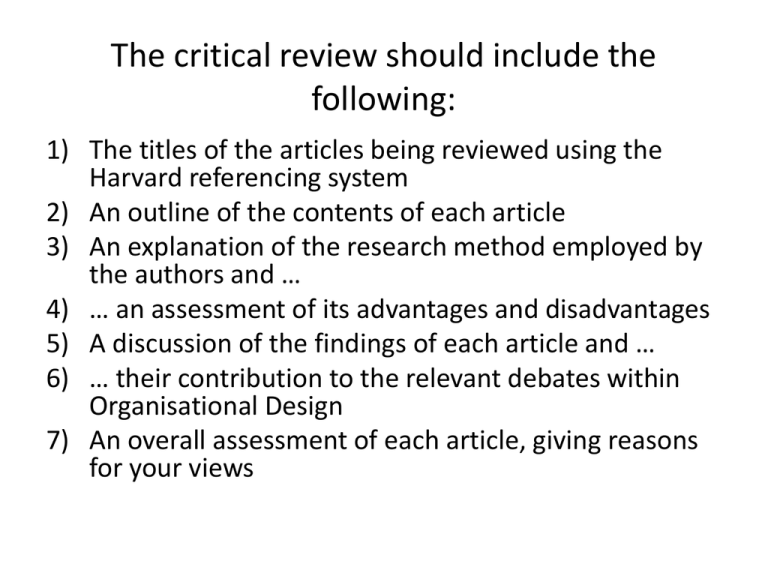
The critical review should include the following: 1) The titles of the articles being reviewed using the Harvard referencing system 2) An outline of the contents of each article 3) An explanation of the research method employed by the authors and … 4) … an assessment of its advantages and disadvantages 5) A discussion of the findings of each article and … 6) … their contribution to the relevant debates within Organisational Design 7) An overall assessment of each article, giving reasons for your views A critical Review of two articles relating to aspects of contemporary organisational design 1 Organisational Design is extremely important area of knowledge: it studies organisations and thus is relevant to all of us, as well as influenced by many different organisations at the same time – as employees, customers, stakeholders, etc. Organisational Design is concerned in particular with how organisations can be designed in order to achieve effective and efficient performance and how they relate to the environment in which they operate. Importance of subject (Point 6) 2 This work is aimed to present the critical review of two articles published in “Organization Studies” journal, relating to important aspects of contemporary Organisational Design: corporate social responsibility and bureaucracy. The first article, “Corporate Social and Financial Performance: A Meta-Analysis”, produced by Mark Orlitzky, Frank L. Schmidt and Sara L. Rynes and published in 2003, presents the study on correlation between corporate social and financial performances and examines, whether concentration on corporate social responsibility issues can help business to win more profit. … Article outline (Point 2) 2 … The second article, “The Persistence of Bureaucracy – A Meta-Analysis of Weber’s Model of Bureaucratic Control” by Eric J. Walton, published in 2005, tries to determine the existence of the bureaucratic model and questions the extent to which Weber’s model of bureaucratic control is relevant to contemporary organisations. Article outline (Point 2) 3 Since the research method used in both studies is meta-analysis, it is important to define it. According to O’Rourke (2007), meta-analysis is the technique of summarizing results from different previous studies. It was used since the 17th century, but first formalized in 1861 by G. Airy: “Summarizing results from different studies eventually became the formalized technique we refer to today as meta-analysis”. The application of this method to the studies presented in articles will be discussed and described further in reviews. Research methods (Point 3) 4 In brief, this work will present the review and overall assessment of two articles. Furthermore, it will discuss the findings of each article and their contribution to the relevant debates within Organisational Design. Refer back to Question Conclusion 21 To sum-up, two articles of a significant importance to Organizational Design field were described and reviewed. Firstly, Orlitzky’s research on Corporate Social Responsibility (CSR) and its implication for modern organizations were described. In comparison to the second article, this one seems to be perfect. It has no criticisms at all, and what is more it has been positively reviewed and was the winner of Moskovitz prize. With one voice, it can be said it represents an outstanding research method that is relevant to the social investment field. The second article also represents a research important for modern organizational design. … 21 … It showed that Weber’s model of bureaucratic control is still relevant in the organisations. However, it had to be criticised due to the small number of studies. Such a limited research was, nonetheless, able to draw upon strong conclusions. All in all, both articles talk about the fields that a modern organization may find crucial. Not only CSR, but also bureaucracy is very important to the organizational design field. The articles should be essential for every manager that wants his company to be successful. 22 Since Organisation Design shapes the nature of the contemporary organisations, it shapes the nature of the world we are living in, and thus it shapes the nature of our lives. That is why it is an essential area of knowledge that every organization should consider. References Barnett, Michael L. and Robert M. Salomon. (2003) "Porous, Pious, and Prosperous: The Curvilinear Relationship Between Social Responsibility and Financial Performance”, Working Paper Liston-Heyes, Catherine (2007) “Corporate Social Responsibility and the Political Environment”, Journal of Corporate Citizenship, Vol.25, pp. 1-14. Griffin, Jennifer J., John F. Mahon (1997) “The Corporate Social Performance and Corporate Financial Performance”, Business & Society, Vol.36, pp. 5–31. Ivanova, Y.V. (2007) “Middle Managers in a StateControlled Economy: How they Implement their Decisions”, Journal of Managerial Psychology, Vol. 22, No. 4, pp. 392-410. Margolis, J. D.,Walsh, J.P. (2001) “People and Profits? The Search for a Link Between a Company’s Social and Financial Performance”, Organization & Management, Vol 22, No. 4, pp. 23-56. Merton, R. K. (1940) “Bureaucratic Structure and Personality”, Social forces, Vol.18, pp. 560 -568. O'Rourke, Keith (2007) "An historical perspective on meta-analysis: dealing quantitatively with varying study results", Social Medicine Vol.100, No 12, pp.579–582. Pfeffer, J. (1997) “New Directions for Organization Theory”, Oxford University Press, New York. Price, J. L. Mueller, C. W. (1986) “Handbook of Organizational Measurement”, Pitman, Boston, MA. Pugh, D. S. Hickson, C. R. Hinings, C R. Turner, C. (1968) ‘”Dimensions of Organizational Structure”, Administrative Science Quarterly, Vol. 13, pp.65-105. Selznick, P. (1949) “TVA and the grass roots”, University of California Press, Berkeley, CA. URL: http://marcorlitzky.webs.com/CV/CV2010pubbdweb2.p df/ (Accessed 12/11/2010) URL: http://www.sristudies.org/Orlitzky+et+al+(2003) (Accessed 9/11/2010) Walton, E. J. (2005) “The Persistence of Bureaucracy – A Meta-Analysis of Weber’s Model of Bureaucratic Control”, Organization Studies, Vol. 26; pp. 569-600. Weber, M. (1946) “From Max Weber: Essays in Sociology”, Oxford University Press, New York. Wood, Donna (2005) “Corporate social performance revisited”, The Academy of Management Review, Vol. 16, No. 4, pp. 691-718. Overall this is a very good piece of work – well researched, well structured and well presented. The review of the first article is excellent; perhaps the review of Walton’s article needed a bit more explanation of his evidence for the conclusions he reached about bureaucracy. You have also made a very good attempt to place the articles within the wider Organisational Design context. Also a very well written assignment. 72%

